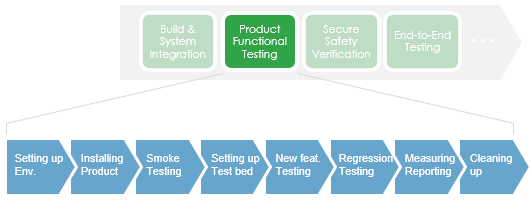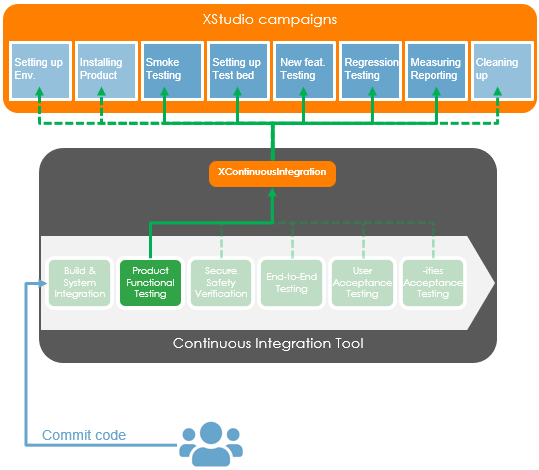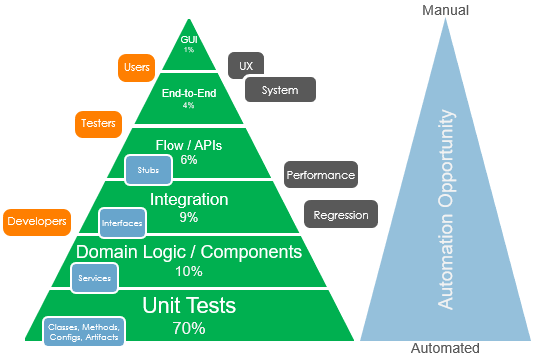Efficient DevOps require adapted testing tools
Keywords:
DevOps
Continuous Integration
Continuous Testing
Continuous Delivery
DevOps
Continuous Integration
Continuous Testing
Continuous Delivery
Abstract: This paper explains why Continuous Testing (CT) 2
is the cornerstone for make DevOps 1 culture efficient in any organization.
We describe what it is, when you use it and how you build it along your projects; We then explain how you can make it happened with XQual and how it works with Continuous Integration (CI) 3 and allows for Continuous Delivery (CD) 4. There's no magic, just relentless engineering and rigor to make it efficient and sustainable. But XQual can tremendously ease the job of the CI loop tool and make CD become a reality.
Isn't this one of the basis for an efficient DevOps organization?
We describe what it is, when you use it and how you build it along your projects; We then explain how you can make it happened with XQual and how it works with Continuous Integration (CI) 3 and allows for Continuous Delivery (CD) 4. There's no magic, just relentless engineering and rigor to make it efficient and sustainable. But XQual can tremendously ease the job of the CI loop tool and make CD become a reality.
Isn't this one of the basis for an efficient DevOps organization?
Summary
Introduction
In any software driven industry, we hear a lot about Continuous Integration (CI) which, in fact,
happens to be a relatively old paradigm. And in the last few years, Continuous Delivery (CD)
seemed to become the new goal for most organization. We tend to agree with the need for
more streamlined and faster pipeline from idea to consumption.
Figure 1: CI, CT and CD
Everyone can notice that Continuous Testing (CT) is seldom mentioned as if it
was a normal consequence or a sub-component of the 2 other patterns. We believe that, to the contrary, CT is clearly a mandatory part of the picture! At least if your
goal is to deliver high quality solutions and products and make your business sustainable on the long run.
CI and CD
Here we present basic notions of Continuous Integration and Continuous Delivery.
CI aims to do the following:- Detect whenever a part of a product has been modified
- (Re)build and (re)assemble a product from its component
- Install that assembly in environments where it can be exercised or used
- Monitor these steps and report on the success/failures to the right stakeholders
CD aims to do the following:
- Detect whenever a product is ready
- Identify and prepare the target environments
- Install (or ship) the product
- Communicate to the right stakeholders, including the users
- Trigger the post install processes (marketing, support, maintenance, monitoring)
Many see CI as the way to make things happen and CD as a potential benefit one gain from
CI. But this is not the entire story.
From the time you modify a part of your product to the time you put in production or ship it
to consumers, there is a set of verifications and validations to need to happen. You need to
answer some questions:
- Is your product still functioning as expected?
- Is it still safe to be used?
- Is the new feature of real value for the users?
- Are we prepared to support it?
- Are we good with our marketing campaigns?
Release Pipeline
So, another useful notion that became more prevalent is the one of release pipeline.
Said it rapidly, it is the process that a product will undergo each time you need release to your users and customers. Defining a release pipeline is just as for any process:- Define the stages
- Determine the conditions to move from one stage to another
- Identify the steps in each stage
- Set the conditions (pre and post) and outcomes you expect from the steps
- And so on
- Build and integrate within system (build & System integration)
- Test functions (Product Quality Tests)
- Check it is safe and secure to use (Security/Safety verification)
- Test integration with surrounding environments (End-to-End testing)
- Ensure users get real value out of it (User Acceptance Testing)
- As needed, verify it is robust, scalable...

Figure 2: A typical release pipeline
Note that the release pipeline does not dictate the set of test environments. System Integration and Product Functional tests can be done on a QA environment, while Security/safety, End to End and User Acceptance tests can be done on a staging environment, and '-ities' tests would be done on a pre-production.

Figure 3: Mapping release stages to environments
It all depends on the set of compliance
you need to achieve (IEC 62304 & ISO 14971, FDA Title 21 CFR Part 11, ISO 14971, and IEC
60601, ISO 26262, DO-178C & DO-254), your own organizational barriers, and how rich you
can be.
So What About CT?
So, a release pipeline realizes 4 types of tasks:- Setting up and cleaning environments when needed
- Installing products
- Verifying and validating
- Taking decisions or helping to make those between stages
At each stage, you need to do specific tests to ensure your new or modified product is delivering on its quality attributes and expected values.
Each time you wish to deliver a new version of the product you must make sure it improves or at list maintain the same level of perceived quality and safety as the prior version while enabling new functionalities or enhancing existing ones.
This is what Continuous Testing brings to the game:
- Relentlessly testing and measuring quality levels
- Doing it as rapidly and effortlessly as possible
- Providing decision makers with the right information for managing the release pipeline
- Automating decision whenever possible

Figure 4: Functional testing stages
Note that the Setting up Env. and Cleaning up can be extremely time consuming and costly depending on the type of product you are addressing (a simple software is not as complex as an automobile for example...).
But the game is to reduce the time of each of these steps.
This allows to pass these steps more often. So, the key word and practice here is automation.
Every step is a Test
Any step (incl. setting up an environment), when it doesn't require too much manual interventions, should be automated and the result should be checked as for any test.
For example, if you are relying on Virtual Machines (VM), you may use Vagrant to load it up and then do some checks to ensure it is up and running. When installing the product, you could use ANSIBLE to deploy and configure and then do some verification on some files. Then you can launch some basic Smoke tests using Robot Framework or SOAPUI for API and so on. You need to use multiple tools and automation test frameworks within a single stage of your
release pipeline.
This is where XQual comes into play.XQual's ability to launch any kind of tests and to interpret and gather the results back, tremendously facilitates the management of a release Pipeline.
You design your campaigns for each step. Once executed, each test session will provide the tests results. Those are used for decision making on what to do as next step.
You use a third-party CI tool to orchestrate the various campaigns.
XQual's XContinuousIntegration is used by these CI tools to launch the various campaigns and to get the reports and test results back.

Figure 5: XContinuousIntegration integration
XContinuousIntegration provides all detailed reports and add a JUNIT formatted synthesis result file that can be parsed by the various CI tools. The CI tools remains the one to decide how to manage the loop (e.g. if the next step can be started or if the current stage should be stopped).
This pattern allows you decoupling the implementation of your steps from the main CI loop.
Detailed results are managed into the XQual Database. All the results are consolidated
through the smart KPI of XQual
Whatever test management tool you use, automation is a key factor if you want to support faster
delivery cycle.XQual supports nearly 90 test automation frameworks and you can add any new one in a matter of hours. But nothing will happen unless you invest in automating the tests.

Figure 6: The_test_pyramid
Given the large set of tools you can choose from when delivering on your test pyramid, getting
the benefit of centralized and versatile test orchestration platform such as XQual is a must to succeed.
Conclusion:
WHEN IT COMES TO TRANSFORM A SOFTWARE DRIVEN ORGANIZATION TO DEVOPS, ONE MUST BE CAREFUL TO
BUILD THE RIGHT PRACTICES AND CULTURE. BUT TRANSFORMATION IS NOT REVOLUTION.
TESTING ACTIVITIES ARE ATTHE HEART OF THE CONTINUOUS DELIVERY. YOU CAN'T CREATE, BUILD AND DELIVER
FASTER, IF YOU DON'T TEST FASTER.
AUTOMATION IS KEY, AS WELL AS INTEGRATING TEST ACTIVITIES INTO THE DELIVERY FLOW
YOU MUST BUILD ON THE TESTING PRACTICES AND TOOLS THAT SIMPLIFY THE TRANSFORMATION. XSTUDIO IS A
KEY ENABLER FOR THIS.
References:
1 DevOps: https://en.wikipedia.org/wiki/DevOps
2 Continuous Testing (CT): https://en.wikipedia.org/wiki/Continuous_testing
3 Continuous Integration (CI): https://en.wikipedia.org/wiki/Continuous_integration
4 Continuous Delivery (CD): https://en.wikipedia.org/wiki/Continuous_delivery
5 Agile: https://agilemanifesto.org/
1 DevOps: https://en.wikipedia.org/wiki/DevOps
2 Continuous Testing (CT): https://en.wikipedia.org/wiki/Continuous_testing
3 Continuous Integration (CI): https://en.wikipedia.org/wiki/Continuous_integration
4 Continuous Delivery (CD): https://en.wikipedia.org/wiki/Continuous_delivery
5 Agile: https://agilemanifesto.org/
Figures:
Figure 1: CI, CT and CD
Figure 2: A typical release pipeline
Figure 3: Mapping release stages to environments
Figure 4: Functional testing stages
Figure 5: XContinuousIntegration integration
Figure 6: The test pyramid
Figure 1: CI, CT and CD
Figure 2: A typical release pipeline
Figure 3: Mapping release stages to environments
Figure 4: Functional testing stages
Figure 5: XContinuousIntegration integration
Figure 6: The test pyramid

